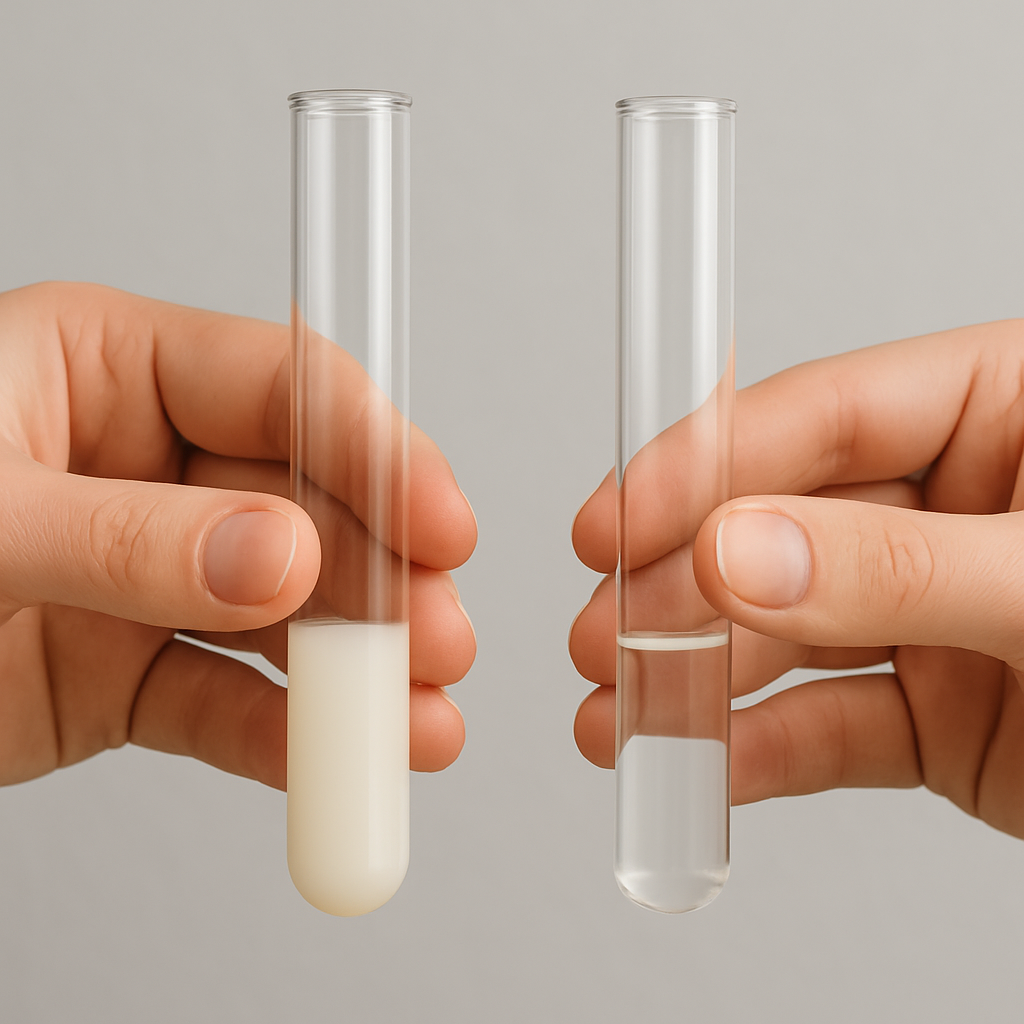Understanding the variations in semen color can be crucial for assessing male reproductive health. While semen is typically white, it can sometimes appear clear, leading to questions about its implications. This article delves into the differences between white and clear semen, exploring their characteristics, causes, and potential health implications.
Understanding Semen Color Variations
Normal Semen Appearance
Semen is generally a whitish-gray fluid with a slightly viscous texture. This appearance is due to the combination of sperm and various fluids from the male reproductive system. The typical color indicates a healthy balance of these components.
- Color : Whitish-gray
- Texture : Slightly viscous
- Components : Sperm and fluids from the prostate, seminal vesicles, and bulbourethral glands
Factors Affecting Semen Color
Several factors can influence the color of semen, ranging from lifestyle choices to health conditions. These factors can cause variations that may be temporary or indicative of underlying issues.
- Diet and Hydration : Certain foods and hydration levels can alter semen color.
- Frequency of Ejaculation : Frequent ejaculation can lead to clearer semen.
- Health Conditions : Infections or medical conditions can change semen color.
White vs Clear Semen Characteristics
Composition of White Semen
White semen is considered normal and healthy. It contains a high concentration of sperm and seminal fluid, which gives it its characteristic color and texture.
- High Sperm Concentration : Indicates healthy sperm production.
- Rich in Seminal Fluid : Provides nutrients and protection for sperm.
- Normal pH Level : Maintains sperm viability.
Properties of Clear Semen
Clear semen often results from frequent ejaculation or low sperm count. It may appear less viscous and more watery, which can be a temporary condition or a sign of an underlying issue.
- Low Sperm Concentration : May indicate reduced fertility.
- Increased Fluid Content : Results in a more watery appearance.
- Possible Causes : Frequent ejaculation, low sperm count, or pre-ejaculation fluid.
Causes of Clear or Watery Semen
Frequent Ejaculation
Frequent ejaculation can lead to clear or watery semen. This is because the body may not have enough time to replenish sperm and seminal fluid between ejaculations.
- Reduced Sperm Count : Less time for sperm production.
- Increased Fluid Ratio : More fluid relative to sperm.
- Temporary Condition : Usually resolves with reduced frequency.
Low Sperm Count
A low sperm count can result in clear semen. This condition, known as oligospermia, can affect fertility and may require medical attention.
- Fertility Concerns : Lower chances of conception.
- Possible Causes : Hormonal imbalances, lifestyle factors, or medical conditions.
- Diagnosis : Requires semen analysis.
Zinc Deficiency
Zinc is crucial for sperm production and overall reproductive health. A deficiency can lead to changes in semen color and quality.
- Impact on Sperm Production : Reduced sperm count and motility.
- Dietary Sources : Meat, shellfish, legumes, and seeds.
- Supplementation : May improve semen quality.
Pre-ejaculation Fluid
Pre-ejaculation fluid, or pre-cum, can appear clear and is often mistaken for semen. It is produced by the Cowper’s glands and serves to lubricate the urethra.
- Function : Lubricates and neutralizes the urethra.
- Appearance : Clear and less viscous.
- Contains Sperm : May contain small amounts of sperm.
Sperm Colors to Be Concerned About
Yellow or Green
Yellow or green semen can indicate an infection or the presence of urine. It is important to seek medical advice if this color persists.
- Possible Infections : STIs or urinary tract infections.
- Urine Presence : May mix with semen.
- Medical Evaluation : Recommended for persistent discoloration.
Red or Red-Brown
Red or red-brown semen may indicate the presence of blood, a condition known as hematospermia. This can be caused by various factors and should be evaluated by a healthcare professional.
- Blood Presence : Indicates possible injury or infection.
- Potential Causes : Prostate issues, infections, or trauma.
- Medical Attention : Necessary for diagnosis and treatment.
Overly Clear
Overly clear semen may suggest a low sperm count or frequent ejaculation. While not always a cause for concern, it can affect fertility.
- Low Sperm Count : Reduced fertility potential.
- Frequent Ejaculation : Temporary condition.
- Monitoring : Recommended if persistent.
Excessively Watery
Excessively watery semen can be a sign of low sperm concentration or other underlying issues. It may require further investigation to determine the cause.
- Low Sperm Concentration : Affects fertility.
- Possible Causes : Hormonal imbalances or lifestyle factors.
- Consultation : Advised for persistent changes.
Factors Influencing Semen Colour and Quality
Caffeine Intake and Its Impact on Sperm
Caffeine consumption can affect sperm quality and semen color. While moderate intake is generally safe, excessive caffeine can have negative effects.
- Impact on Sperm Motility : May reduce sperm movement.
- Recommended Intake : Limit to moderate levels.
- Sources : Coffee, tea, energy drinks, and chocolate.
Nutritional Influence
Diet plays a significant role in semen quality and color. A balanced diet rich in essential nutrients supports healthy sperm production.
- Essential Nutrients : Zinc, selenium, and antioxidants.
- Dietary Sources : Fruits, vegetables, nuts, and whole grains.
- Impact on Semen : Improves color and quality.
Frequent Ejaculation
As mentioned earlier, frequent ejaculation can lead to clearer semen. Balancing ejaculation frequency can help maintain optimal semen quality.
- Impact on Semen Quality : Temporary changes in color and consistency.
- Recommended Frequency : Varies by individual.
- Monitoring : Adjust frequency as needed.
Health Implications of Semen Color Changes
When to Seek Medical Attention
Changes in semen color can be a normal variation or a sign of a health issue. It is important to seek medical advice if changes persist or are accompanied by other symptoms.
- Persistent Changes : Lasting more than a week.
- Accompanying Symptoms : Pain, discomfort, or fever.
- Professional Evaluation : Necessary for diagnosis.
Potential Underlying Conditions
Semen color changes can indicate underlying health conditions that require medical attention. Identifying these conditions early can improve outcomes.
- Infections : STIs or urinary tract infections.
- Prostate Issues : Inflammation or enlargement.
- Hormonal Imbalances : Affecting sperm production.
Improving Semen Quality and Color
Lifestyle Modifications
Adopting a healthy lifestyle can improve semen quality and color. This includes regular exercise, adequate sleep, and stress management.
- Exercise : Supports overall health and sperm production.
- Sleep : Essential for hormonal balance.
- Stress Management : Reduces negative impacts on fertility.
Dietary Considerations
A nutrient-rich diet can enhance semen quality. Focus on foods that provide essential vitamins and minerals for reproductive health.
- Zinc and Selenium : Important for sperm health.
- Antioxidants : Protect sperm from damage.
- Balanced Diet : Includes a variety of food groups.
Supplements for Sperm Health
Certain supplements can support sperm health and improve semen quality. Consult a healthcare professional before starting any supplement regimen.
- Zinc Supplements : Boost sperm production.
- Omega-3 Fatty Acids : Improve sperm motility.
- Multivitamins : Provide essential nutrients.
Fertility and Semen Consistency
Can Clear Semen Lead to Pregnancy?
Clear semen can still contain sperm, but its fertility potential may be reduced. The likelihood of pregnancy depends on the sperm count and motility.
- Sperm Presence : Possible in clear semen.
- Fertility Potential : May be lower than normal.
- Consultation : Advised for fertility concerns.
Assessing Sperm Count at Home
Home sperm tests can provide an initial assessment of sperm count. These tests are convenient but should be followed by a professional evaluation for accurate results.
- Home Test Kits : Available for initial assessment.
- Professional Evaluation : Recommended for comprehensive analysis.
- Limitations : Home tests may not assess all fertility factors.
Final Thoughts on Semen Color Differences
Understanding the differences between white and clear semen can help individuals make informed decisions about their reproductive health. While variations in color are often normal, persistent changes should be evaluated by a healthcare professional. By adopting a healthy lifestyle and seeking medical advice when necessary, individuals can maintain optimal semen quality and fertility.
FAQs
Is it normal for semen to be clear sometimes?
Yes, it is normal for semen to be clear sometimes, especially after frequent ejaculation. This is usually a temporary condition and not a cause for concern. However, if the clear appearance persists, it may be worth consulting a healthcare professional.
What does it mean if my semen is watery?
Watery semen can indicate a low sperm count or frequent ejaculation. While it may not always be a concern, persistent watery semen should be evaluated by a healthcare provider to rule out underlying issues.
Can clear semen still contain sperm?
Yes, clear semen can still contain sperm, although the concentration may be lower. This can affect fertility, but it does not necessarily mean that conception is impossible. A semen analysis can provide more information about sperm count and quality.
How can I increase my sperm count naturally?
Increasing sperm count naturally involves adopting a healthy lifestyle, including a balanced diet, regular exercise, and adequate sleep. Reducing stress and avoiding harmful substances like tobacco and excessive alcohol can also improve sperm health.


